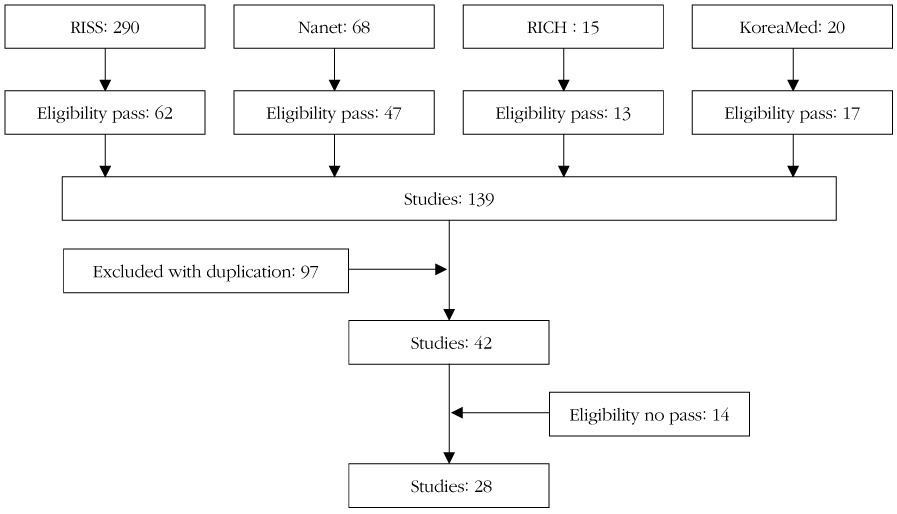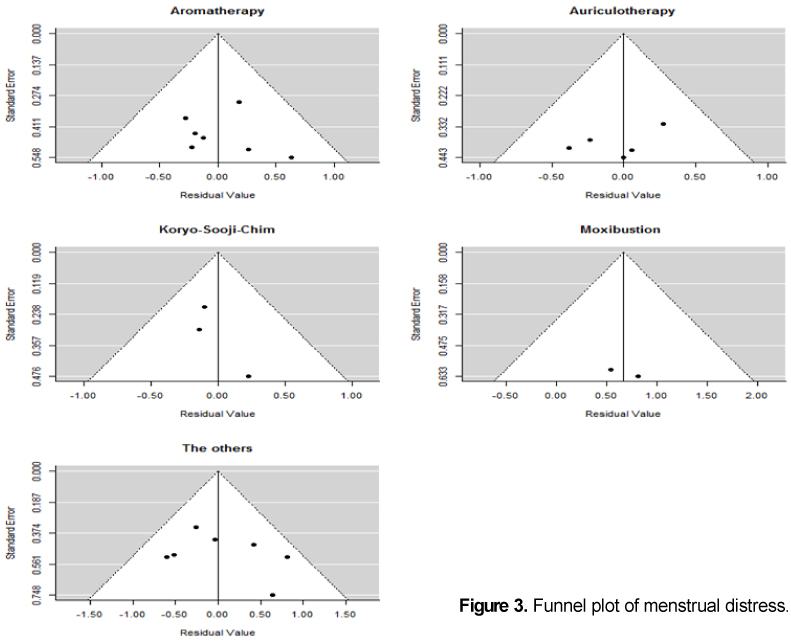Korean J Women Health Nurs.
2013 Mar;19(1):23-35. 10.4069/kjwhn.2013.19.1.23.
Meta-analysis of Complementary and Alternative Intervention on Menstrual Distress
- Affiliations
-
- 1Chosun Nursing College, Gwangju, Korea.
- 2Department of Nursing, Nambu University, Gwangju, Korea. pmk0220@nambu.ac.kr
- 3Department of Statistics, Chonnam National University, Gwangju, Korea.
- KMID: 2307962
- DOI: http://doi.org/10.4069/kjwhn.2013.19.1.23
Abstract
- PURPOSE
This study was to analyze the effect size of complementary and alternative intervention studies in reference to dysmenorrhea and menstrual distress.
METHODS
In order to conduct a meta-analysis, a total of 393 studies were retrieved from the database. Twenty-eight studies that were published from March 2001 to February 2011 were selected.
RESULTS
Intervention studies included seven studies on aromatherapy, five on auriculotherapy, three on each Koryo-Sooji-Chim and moxibustion, two on each heat therapy and magnetic therapy and six on other therapy. The effect size of the intervention studies on dysmenorrhea and menstrual distress was greater than 0.48 for Koryo-Sooji-Chim, moxibustion, aromatherapy, auriculotherapy and other therapy.
CONCLUSION
This study suggests that drug free therapy can reduce the levels of menstrual distress, despite the small number of intervention studies and randomized controlled trials.
Keyword
MeSH Terms
Figure
Cited by 1 articles
-
Effect of Heated Red Bean Pillow Application for College Women with Dysmenorrhea
Jeung-Im Kim
Korean J Women Health Nurs. 2013;19(2):67-74. doi: 10.4069/kjwhn.2013.19.2.67.
Reference
-
1. Borenstein JE, Dean BB, Endicott J, Wong J, Brown C, Dickerson V, et al. Health and economic impact of the premenstrual syndrome. J Reprod Med. 2003. 48:515–524.2. Borenstein M, Hedges LV, Higgins JPT, Rothstein HR. Introduction to meta-analysis. 2009. West Sussex: Wiley.3. Carlin B. Comment on hierarchial models for combining information and for meta-analysis, Bayesian statistics. 1992. 4th ed. Oxford: Oxford University Press.4. Choi EH. Comparison of effects lavender abdominal massage and inhalation on dysmenorrhea, pain, anxiety and depression. J Korean Acad Fundam Nurs. 2009. 16:300–306.5. Cohen J. Statistical power analysis for the behavioral science. 1988. 2nd ed. New Jersey: Lawrence Erlbaum Associate, Inc.6. Ezzo JM, Richardson MA, Vickers A, Allen C, Dibble SL, Issell BF, et al. Acupuncture-point stimulation for chemotherapy-induced nausea or vomiting. 2006. Retrieved from Jun, 20, 2010. http://onlinelibrary.wiley.com/cochranelibrary/search.7. Gilly A. Woman's sexual health. 2001. 2nd ed. London: Harcourt.8. Han SH, Hur MH. A study on the menstrual pain and dysmenorrhea, factors influenced to them and self management method for them of college students. J Korean Acad Soc Nurs Educ. 1999. 5:359–375.9. Health Insurance Review & Assessment Service. HIRA's guideline for undertaking systematic reviews. 2011. Seoul: Health Insurance Review & Assessment Service.10. Hwang WY. Women's menstrual discomforts and coping. Nurs Sci. 2004. 16:41–50.11. Jun EM. Effects of the SP-6 acupressure on dysmenorrhea, skin temperature of the CV2 acupoint and temperature in the college students. Korean J Women Health Nurs. 2003. 9:128–137.12. Kim JE. Comprehensive understanding of perimenstrual discomfort: A triangulation of methods and perspectives. 1995. Seoul: Seoul National University;Unpublished master's thesis.13. Kim MY, Jung MS, Chung KA. Degree of dysmenorrhea and self-management of dysmenorrhea in the high-school girl student. Korean J Women Health Nurs. 2000. 6:413–426.14. Kim SY, Lee HY. Effect of the auricular acupressure therapy on dysmenorrhea of puberty girls. Korean J Women Health Nurs. 2010. 16:20–28. http://dx.doi.org/10.4069/kjwhn.2010.16.1.20.
Article15. Kim T. Pathogenesis and management guideline of dysmenorrhea. Korean J Obstet Gynecol. 2005. 48:1613–1620.16. Kim YH, Lee IS. A study on the dysmenorrhea in college female students. Korean J Women Health Nurs. 2002. 8:85–95.
Article17. Lee KH, Lee YS, Ko MS, Kim HJ, Park LJ, Park YJ, et al. Maternity & Women's Health Nursing 2. 2010. Seoul: Hyunmoon Publisher.18. Moos RH. The development of a menstrual distress questionnaire. Psychosom Med. 1968. 30:853–867.
Article19. Morris C, Normand S. Hierarchial models for combining information and for meta-analysis, Bayesian Statistics, 4. 1992. Oxford: Oxford University Press.20. Park MH. Understanding and application of evidence based nursing. 2006. Seoul: Koonja Publisher.21. Ryu SW. Systematic review on complementary and alternative medicine for dysmenorrhea. 2008. Iksan: Wonkwang University;Unpublished master's thesis.22. Song HH. Meta analysis from medical, nursing, and social science research. 2006. Seoul: Chungsoon Publisher.23. Song HJ. Meta-analysis on the effect of nursing interventions for relieving perimenstrual discomfort. 2006. Seoul: Korea University;Unpublished master's thesis.24. Taylor D. Perimenstrual symptoms and syndromes: Guidelines for symptom management and self-care. Adv Stud Med. 2005. 5:228–241.25. Tseng YF, Chen CH, Yang YH. Rose tea relief of primary dysmenorrhea in adolescents: A randomized controlled trial in Taiwan. J Midwifery Womens Health. 2005. 50:e51–e57.
- Full Text Links
- Actions
-
Cited
- CITED
-
- Close
- Share
- Similar articles
-
- Relationship between Menstruation Distress and Coping Method among 3-shift Hospital Nurses
- Relationship between Menstrual Distress and Sleep Disturbance in Middle-school Girls
- Effects of Artemisia A. Smoke(Ssukjahun) on Menstrual Distress, Dysmenorrhea, and Prostaglandin F2alpha
- A Study on Community Health Practitioners' Knowledge of, Use Patterns of, and Attitudes toward Complementary and Alternative Medicine(CAM)
- Research Trend about Complementary and Alternative Therapy in Korea using Text Network Analysis




